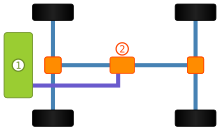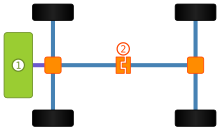I copy and paste it from the German Wikipedia Side, in my opinion a good explanation of above topic.
and the translation by deepl.:
Differenzialgesteuerter (permanenter) Allradantrieb

Der
permanente Allradantrieb mit
Zentraldifferenzial
1: Motor
2: Zentraldifferenzial
Bei Fahrzeugen mit permanentem Allradantrieb wird die Motorleistung ständig auf alle vier Räder übertragen und durch die Differenziale wird der vollständige Drehzahlausgleich ohne Leistungsverluste gewährleistet. Um Verspannungen im Antriebsstrang zu vermeiden, wird ein zusätzliches Zentraldifferenzial zwischen Vorder- und Hinterachse eingebaut. Der Nachteil hierbei ist jedoch, dass bei fehlender Bodenhaftung eines einzelnen Rades oder einer Achse das übertragbare Antriebsmoment durch dieses Rad oder diese Achse begrenzt wird, sodass ein Fahrzeug im Extremfall nicht mehr aus eigener Kraft bewegt werden kann. Aus diesem Grund wird bei Fahrzeugen mit permanentem Allradantrieb häufig entweder das Zentraldifferenzial als
Sperrdifferenzial ausgeführt (beispielsweise die
Torsen-Differenziale in früheren
Audi-
quattro-Modellen mit längseingebautem Motor), oder es gibt elektronische Traktionshilfen wie
Antriebsschlupfregelung (ASR). In Geländewagen wie zum Beispiel dem
Land Rover Defender steht dagegen ein manuell sperrbares Mittendifferenzial zur Verfügung, das je nach Untergrundbeschaffenheit vom Fahrer gesperrt werden kann.
Durch die Bauart des Zentraldifferenzials wird bestimmt, ob das Antriebsmoment gleichmäßig (50 : 50) oder ungleichmäßig auf beide Achsen aufgeteilt wird. Die Verteilung ist für das Fahrverhalten maßgebend. Da an Steigungen und beim Beschleunigen durch die dynamische Achslastverschiebung zusätzlich Gewicht auf die Hinterachse verlagert wird, ist es üblich, auch beim Antriebsmoment einen höheren Anteil auf die Hinterachse zu übertragen. Daher werden in vielen Fahrzeugen die Drehmoment-Aufteilungen zwischen Vorderachse und Hinterachse von 45 : 55 (V : H) bis 33 : 67 gewählt. Diese Verteilung ist fest. Lässt sich aber das Zentraldifferenzial sperren, kann die Leistung nach der an den Achsen gegebenen verteilt werden. Auch Zentraldifferenziale mit elektronischer
Reiblamellenkupplung lassen Kraftverteilungen bis 100 : 0 und 0 : 100 zu.
Differential-controlled (permanent) all-wheel drive
Permanent all-wheel drive with central differential
1: Engine
2: Central differential
In vehicles with permanent all-wheel drive, the engine power is constantly transmitted to all four wheels and the differentials ensure complete speed compensation without any loss of power. To avoid tension in the drive train, an additional center differential is installed between the front and rear axles. The disadvantage of this, however, is that if a single wheel or axle does not grip the ground, the transmissible drive torque is limited by this wheel or axle, meaning that in extreme cases a vehicle can no longer be moved under its own power. For this reason, in vehicles with permanent all-wheel drive, either the center differential is often designed as a limited slip differential (e.g. the Torsen differentials in earlier Audi quattro models with longitudinally mounted engines), or there are electronic traction aids such as traction control (ASR). In off-road vehicles such as the Land Rover Defender, on the other hand, a manually lockable center differential is available, which can be locked by the driver depending on the surface conditions.
The design of the center differential determines whether the drive torque is distributed evenly (50:50) or unevenly to both axles. The distribution is decisive for the driving behavior. As additional weight is shifted to the rear axle on inclines and when accelerating due to the dynamic axle load shift, it is common practice to transfer a higher proportion of the drive torque to the rear axle. For this reason, the torque distribution between the front axle and rear axle in many vehicles ranges from 45 : 55 (V : H) to 33 : 67. This distribution is fixed. However, if the center differential can be locked, the power can be distributed according to the power given to the axles. Central differentials with electronic multi-plate clutches also allow power distribution up to 100 : 0 and 0 : 100.
Kupplungsgesteuerter (zuschaltbarer) Allradantrieb

Der mit
Klauenkupplungzuschaltbare Allradantrieb
1: Motor
2: Klauenkupplung
Bei Fahrzeugen mit zuschaltbarem Allradantrieb wird unter normalen Fahrbedingungen nur eine Achse angetrieben. Erst bei glatter Fahrbahn oder auf rutschigem Untergrund wird der Antrieb der zweiten Achse zugeschaltet. Dadurch wird die Traktion des Fahrzeugs erhöht.
Für das Zuschalten der zweiten Antriebsachse gibt es verschiedene Bauarten:
- Im einfachsten Fall wird eine Klauenkupplung an der Antriebswelle geschlossen.
- Ein sperrbarer Freilauf an der Radnabe verbindet die Antriebswelle mit dem Rad (bei manuell schaltbaren Naben muss das Fahrzeug verlassen werden).
Durch den fehlenden Drehzahlausgleich der starren Verbindung kann es zu Verspannungen im Antriebsstrang und gelegentlichen Geräuschen beim Einparken kommen. Bei Kurvenfahrt folgen die Vorderräder einem größeren Radius und müssen sich schneller drehen als die Hinterräder, werden aber gezwungen, sich genauso schnell wie die Hinterräder zu drehen. Das führt – je nach Auslegung des
Fahrwerks – zu reduziertem
Übersteuern oder verstärktem
Untersteuern. Dieses kostengünstig zu produzierende Allradantriebssystem wurde häufig in der
Kleinwagenklasse verwendet. Als Beispiele hierfür seien der
Fiat Panda 4×4 (der Jahre 1983–2003),
Subaru Justy und
Subaru Vivio sowie der
Citroën AX 4×4 genannt.
drive
The all-wheel drive that can be engaged with a dog clutch
1: Engine
2: Claw clutch
In vehicles with selectable all-wheel drive, only one axle is driven under normal driving conditions. The drive of the second axle is only engaged when the road is slippery or the surface is slippery. This increases the traction of the vehicle.
There are various designs for engaging the second drive axle:
In the simplest case, a claw clutch is closed on the drive shaft.
A lockable freewheel on the wheel hub connects the drive shaft to the wheel (in the case of manually shiftable hubs, the vehicle must be left).
The lack of speed compensation of the rigid connection can lead to tension in the drivetrain and occasional noises when parking. When cornering, the front wheels follow a larger radius and have to turn faster than the rear wheels, but are forced to turn just as fast as the rear wheels. Depending on the design of the chassis, this leads to reduced oversteer or increased understeer. This low-cost all-wheel drive system was frequently used in the small car class. Examples include the Fiat Panda 4×4 (1983-2003), Subaru Justy and Subaru Vivio as well as the Citroën AX 4×4.





